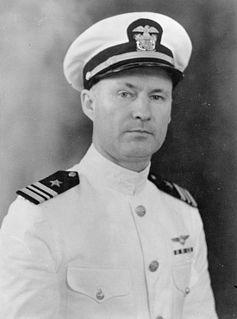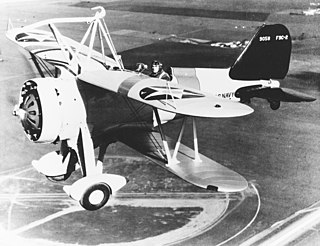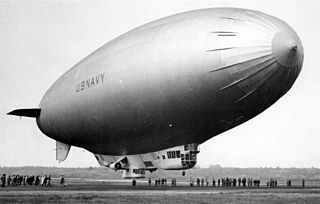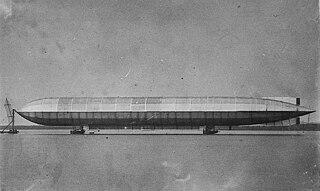| DN-1 | |
|---|---|
 | |
| DN-1 approaching its floating hangar at Pensacola. | |
| Role | Experimental airship |
| Manufacturer | Connecticut Aircraft |
| First flight | 20 April 1917 |
| Number built | 1 |
The DN-1 was the United States Navy's first airship.
| DN-1 | |
|---|---|
 | |
| DN-1 approaching its floating hangar at Pensacola. | |
| Role | Experimental airship |
| Manufacturer | Connecticut Aircraft |
| First flight | 20 April 1917 |
| Number built | 1 |
The DN-1 was the United States Navy's first airship.
Captain Mark L. Bristol, the second Director of Naval Aviation, supported the development of the dirigible in the anti-submarine role. [1] Victor Herbster, Holden Richardson and LCDR Frank McCrary drew up the specifications for the DN-1. [1] The contract was awarded on 1 June 1915 to the Connecticut Aircraft Company of New Haven, CT. [2] The U.S. Navy had no experience with airships and it seems neither had any of the principals of Connecticut Aircraft Company. They were a lawyer who was the financial backer, an amusement park owner who acted as manager; the technical staff was an Austrian, Hans Otto Stagel, who claimed to be a dirigible pilot and a German engineer and mechanic, who claimed to be Zeppelin experts. [3] [4] Jerome Clarke Hunsaker of MIT and his assistant Donald Wills Douglas, later founder of the Douglas Aircraft Company, aided the Connecticut Aircraft Company in the design of DN-1. [5] [6] The Chief Engineer was James F. Boyle and the Production Manager was J.J. DeLunay. The civilian inspector was Thomas Scott Baldwin and the resident Navy inspector was Frank M. McCrary. [4] [7]
The DN-1 was roughly based on the German Parseval type of non-rigid airship. The envelope was made of two layers of cloth, with rubber between them. The outer layer of fabric was yellow to prevent deterioration caused by light. [8] The gondola control car, built by George Lawley & Son of Dorchester, Massachusetts, was a large rectangular box with two four-bladed propellers on outriggers. There were originally two engines, built by the B. F. Sturtevant Company of Hyde Park, MA, mounted in the open gondola, and the propellers could be swiveled to provide thrust in either the horizontal or vertical planes. [9] A 1+1⁄2 hp (1.1 kW) Indian engine was provided to maintain air pressure in the two ballonets when the engine was not running. [10] The gondola was water-tight as the Navy intended to operate the DN-1 to take-off from and land on water. [11] The specification for the DN-1 provided for being capable of being moored to a mooring mast which had first been used with HMA No. 1 in 1911. [12] The DN-1 was photographed beside a mooring mast but there appears to be no evidence it was ever moored to it. [4]
The DN-1 was ballyhooed in the press before its flight program. [13] The DN-1 was shipped to Pensacola, Florida, in late 1916 and assembled in a floating hangar constructed for it. The day of the planned first flight, the DN-1 was removed from its hangar, only to lose lift and sink. Crew member Petty Officer James F. Shade, up to his chin in the water, invited spectators to come aboard for "the first submerged flight of the DN-1." [14] The DN-1 was returned to its hangar and lightened. One step taken to lighten the DN-1 was the removal of one engine. [13]
When the test program began on 20 April 1917 the DN-1 was a disappointment. DN-1 lacked lift, barely met the speed requirement of 35 miles per hour (56 km/h) and the transmission overheated, melting the bearings. The DN-1 was piloted for its first flight by LCDR Frank M. McCrary USN, LT Stanley V. Parker assisted by PO Jimmy Shade. [15] It was 27 April before the airship flew again. Two days later the handling party which was attempting to tow the airship across the water damaged the DN-1.The Navy decided that the airship was not worth repairing and the DN-1 was scrapped. [11] [16] The "Rigid Airship Manual (GPO, 1928) commented upon the DN-1 "was so overweight that it could barely lift itself off the ground. It's envelope leaked and the power plant functioned badly. It did, however, actually fly and since the firm had built the ship in good faith and at a cost greatly in excess of the contract price[$45,636], it was formally accepted." [17]
The DN-1 was an inept failure, being barely capable of flight, delivered long after the planned time, and way over budget. The DN-1 made the Navy realize it did not have the technical skills and knowledge needed to construct airships. [16] [17] The authoritative Jane's All the World's Aircraft described the DN-1 as "of small size, that it was of no practical value; that it was interesting only as an experiment." [4] The DN-1 forced the Navy to take a more effective approach to following airship development depending upon more reliable contractors and closer involvement of the Navy in design and management. [16] [18] The subsequent B, C, and D-Class airships were quite successful. [19]
After its demise the DN-1 came to be considered the A class. Such designation was never officially used by the Navy, nor was it used during DN-1's short life. [16]
General characteristics
Performance
Related lists

A blimp, or non-rigid airship, is an airship (dirigible) without an internal structural framework or a keel. Unlike semi-rigid and rigid airships, blimps rely on the pressure of the lifting gas inside the envelope and the strength of the envelope itself to maintain their shape.

An airship or dirigible balloon is a type of aerostat or lighter-than-air aircraft that can navigate through the air under its own power. Aerostats gain their lift from a lifting gas that is less dense than the surrounding air.

USS Shenandoah was the first of four United States Navy rigid airships. It was constructed during 1922–1923 at Lakehurst Naval Air Station, and first flew in September 1923. It developed the U.S. Navy's experience with rigid airships and made the first crossing of North America by airship. On the 57th flight, Shenandoah was destroyed in a squall line over Ohio in September 1925.

This is a list of aviation-related events from 1915:
This is a list of aviation-related events from 1904:

Charles Emery Rosendahl was a highly decorated vice admiral in the United States Navy, and an advocate of lighter-than-air flight.

The Curtiss F9C Sparrowhawk is a light 1930s biplane fighter aircraft that was carried by the United States Navy airships USS Akron and Macon. It is an example of a parasite fighter, a small airplane designed to be deployed from a larger aircraft such as an airship or bomber.

Lakehurst Maxfield Field, formerly known as Naval Air Engineering Station Lakehurst, is the naval component of Joint Base McGuire–Dix–Lakehurst, a United States Air Force-managed joint base headquartered approximately 25 miles (40 km) east-southeast of Trenton in Manchester Township and Jackson Township in Ocean County, New Jersey, United States. It is primarily the home to Naval Air Warfare Center Aircraft Division Lakehurst, although the airfield supports several other flying and non-flying units as well. Its name is an amalgamation of its location and the last name of Commander Louis H. Maxfield, who lost his life when the R-38/USN ZR-2 airship crashed during flight on 24 August 1921 near Hull, England.

The K-class blimp was a class of blimps built by the Goodyear Aircraft Company of Akron, Ohio for the United States Navy. These blimps were powered by two Pratt & Whitney Wasp nine-cylinder radial air-cooled engines, each mounted on twin-strut outriggers, one per side of the control car that hung under the envelope. Before and during World War II, 134 K-class blimps were built and configured for patrol and anti-submarine warfare operations, and were extensively used in the Navy’s anti-submarine efforts in the Atlantic and Pacific Ocean areas.

The L-class blimps were training airships operated by the United States Navy during World War II. In the mid-1930s, the Goodyear Aircraft Company built a family of small non-rigid airships that the company used for advertising the Goodyear name. In 1937 the United States Navy awarded a contract for two different airships, K-class blimp designated K-2 and a smaller blimp based upon Goodyear's smaller commercial model airship used for advertising and passenger carrying. The smaller blimp was designated by the Navy as L-1. It was delivered in April 1938 and operated from the Navy's lighter-than-air facility at Lakehurst, New Jersey. In the meantime, the Navy ordered two more L-Class blimps, the L-2 and L-3, on September 25, 1940. These were delivered in 1941. L-2 was lost in a nighttime mid-air collision with the G-1 on June 8, 1942.

The Goodyear Aircraft Company of Akron, Ohio built the M-class blimp for the US Navy as the follow-on to the K-class anti-submarine warfare blimp used during World War II. It was a significantly larger airship, 50% larger than its predecessor. Four airships, designated M-1 through M-4, were delivered in early 1944. Operations of K-ships in tropical regions had shown a need for a blimp with greater volume to offset the loss of lift due to high ambient temperatures.

The N-Class, or as popularly known, the "Nan ship", was a line of non-rigid airships built by the Goodyear Aircraft Company of Akron, Ohio for the US Navy. This line of airships was developed through many versions and assigned various designators as the airship designation system changed in the post World War II era. These versions included airships configured for both anti-submarine warfare and airborne early warning (AEW) missions.

Beginning in 1908 and lasting until 1937, the U.S. Army established a program to operate airships. With the exceptions of the Italian-built Roma and the Goodyear RS-1, which were both semi-rigid, all Army airships were non-rigid blimps. These airships were used primarily for search and patrol operations in support of coastal fortifications and border patrol. During the 1920s, the Army operated many more blimps than the U.S. Navy. They were also used because they were not seen as "threats" on the battlefield by opposing forces, unlike airplanes, due to their passive role in combat.

The B class blimps were patrol airships operated by the United States Navy during and shortly after World War I. The Navy had learned a great deal from the DN-1 fiasco. The result was the very successful B-type airships. Dr. Jerome Hunsaker was asked to develop a theory of airship design, Lt. John H. Towers had returned from Europe having inspected British designs, and using reports from attachés on British airship operations, the Navy was prepared to seek bids for blimps from American manufacturers. On 4 February 1917 the Secretary of the Navy directed that 16 nonrigid airships of Class B be procured. A February 12, 1917 meeting with the Chief of the Bureau of Construction and Repair, and representatives of Goodyear, Goodrich, Connecticut Aircraft Company, Curtiss Aeroplane and Motor Corporation, and U.S. Rubber Company, it was agreed that the order for 16 dirigibles was beyond the capability of any one company. The conference resulted in a committee to coordinate on sharing raw materials, information and experience. Ultimately Goodyear manufactured 9 envelopes, Goodrich made 5 and Curtiss assembled the gondolas for all of those 14 ships. Connecticut Aircraft contracted with U.S. Rubber for its two envelopes and with Pigeon Fraser for its gondolas. The Curtiss-built gondolas used by Goodyear and Goodrich used modified Curtiss JN-4 fuselages powered by Curtiss OXX engines. The Connecticut Aircraft blimps were powered by Hall-Scott engines. One ship, B-20 was equipped with a special control car. All B-Class airships were delivered to the Navy between August 1917 (B-1) and September 1918 (B-20).

The D class blimp was a patrol airship used by the US Navy in the early 1920s. The D-type blimps were slightly larger than the C-type and had many detail improvements. The Navy continued the practice of dividing the envelope production between Goodyear and Goodrich. The control cars were manufactured by the Naval Aircraft Factory. The major improvements over the C-type blimps were a better control car design and easier, more reliable controls and instrumentation. The engines were moved to the rear to reduce noise and allow better communications between crew members. The fuel tanks were suspended from the sides of the envelope. The envelope was identical to the C-type, except an additional six-foot panel was inserted for a total length of 198 feet (60 m) and a volume of 190,000 cubic feet (5,400 m3). The last of the D-Class, D-6, had a different control car designed by Leroy Grumman who later founded the Grumman Aircraft Engineering Corporation.

Hangar No. 1 is an airship hangar located at Naval Air Engineering Station Lakehurst in Manchester Township, in Ocean County, New Jersey, United States. It was the intended destination of the rigid airship LZ 129 Hindenburg prior to the Hindenburg disaster on May 6, 1937, when it burned while landing. Built in 1921, it is one of the oldest surviving structures associated with that period's development of lighter-than-air flight. It was designated a National Historic Landmark in 1968.

His Majesty's Airship No. 1 was designed and built by Vickers, Sons and Maxim at their works in Barrow-in-Furness, Lancashire, England, as an aerial scout airship for the Royal Navy. It was the first British rigid airship to be built, and was constructed in a direct attempt to compete with the German airship programme. Often referred to as "Mayfly", a nickname given to it by the lower deck, in public records it is designated ‘HMA Hermione’ because the naval contingent at Barrow were attached to HMS Hermione, a cruiser moored locally preparing to act as its tender.

The Lebaudy République was a semi-rigid airship built for the French army in Moisson, France, by sugar manufacturers Lebaudy Frères. She was a sister ship of the Patrie, the main differences between the two being in the dimensions of the gasbag and the ballonet. Although she was operationally successful, the République crashed in 1909 due to a mechanical failure, killing all four crew members.

A squadron in air force, army aviation, or naval aviation is a unit comprising a number of military aircraft and their aircrews, usually of the same type, typically with 12 to 24 aircraft, sometimes divided into three or four flights, depending on aircraft type and air force. Land based squadrons equipped with heavier type aircraft such as long-range bombers, cargo aircraft, or air refueling tankers have around 12 aircraft as a typical authorization, while most land-based fighter equipped units have an authorized number of 18 to 24 aircraft.